Forest Transition in Madagascar’s Highlands: Initial Evidence and Implications
Abstract
:1. Introduction
1.1. Theoretical Motivations
1.2. Forest Change Studies in Madagascar and Advances in Remote Sensing
2. Study Area
3. Methods
3.1. Remotely Sensed Data, Digital Image Processing and Change Detection
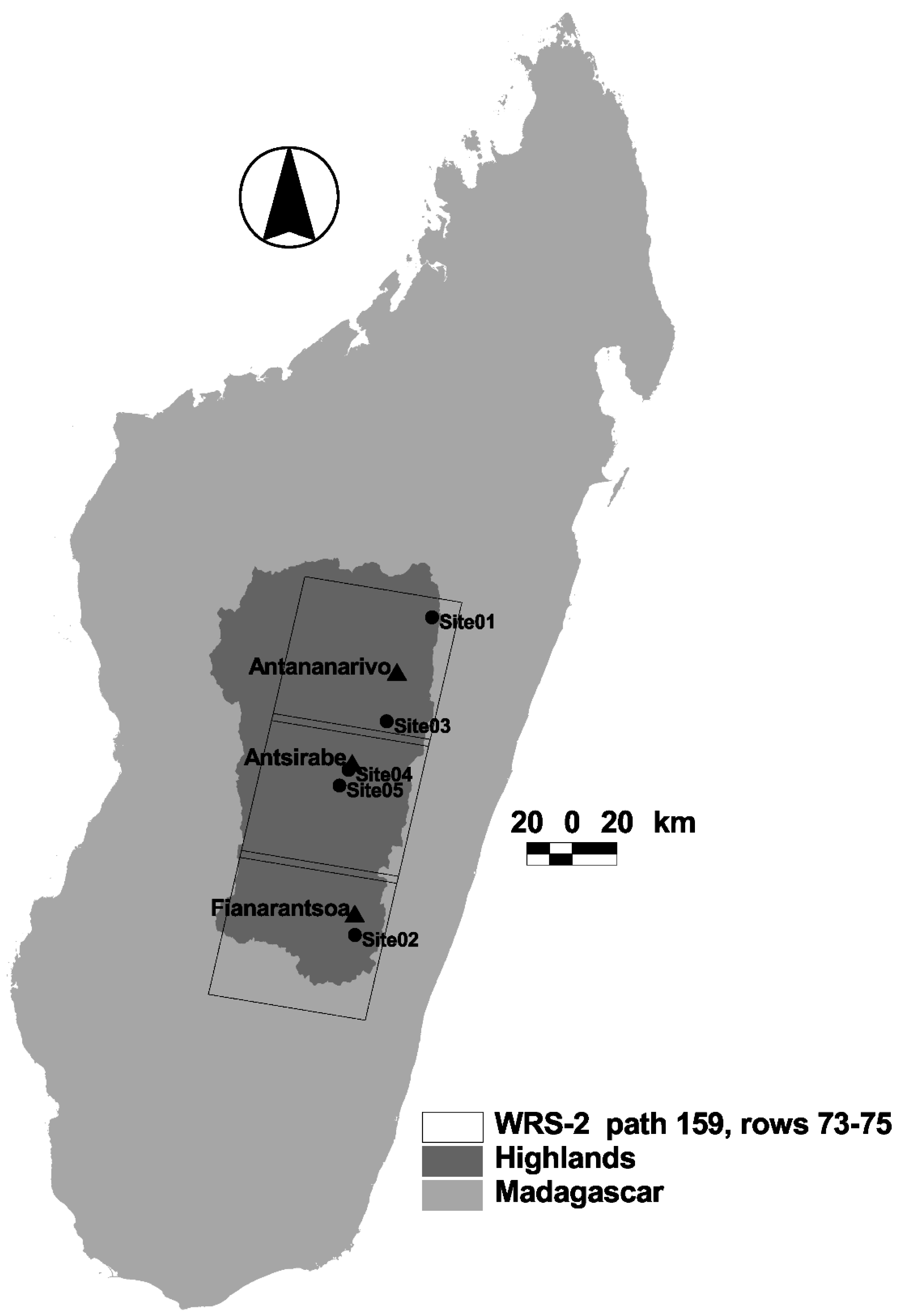
| Band | Slope | Intercept | R2 |
|---|---|---|---|
| Blue | 0.013 | −51.128 | 0.928 |
| Green | 0.007 | −28.163 | 0.910 |
| Red | 0.008 | −33.207 | 0.949 |
| Near Infrared | 0.006 | −20.427 | 0.971 |
| Shortwave Infrared 1 | 0.010 | −44.685 | 0.986 |
| Shortwave Infrared 2 | 0.007 | −32.121 | 0.978 |
3.2. Explaining the Observed Woodland Dynamics
4. Results
4.1. Remote Sensing and Case Study Analysis
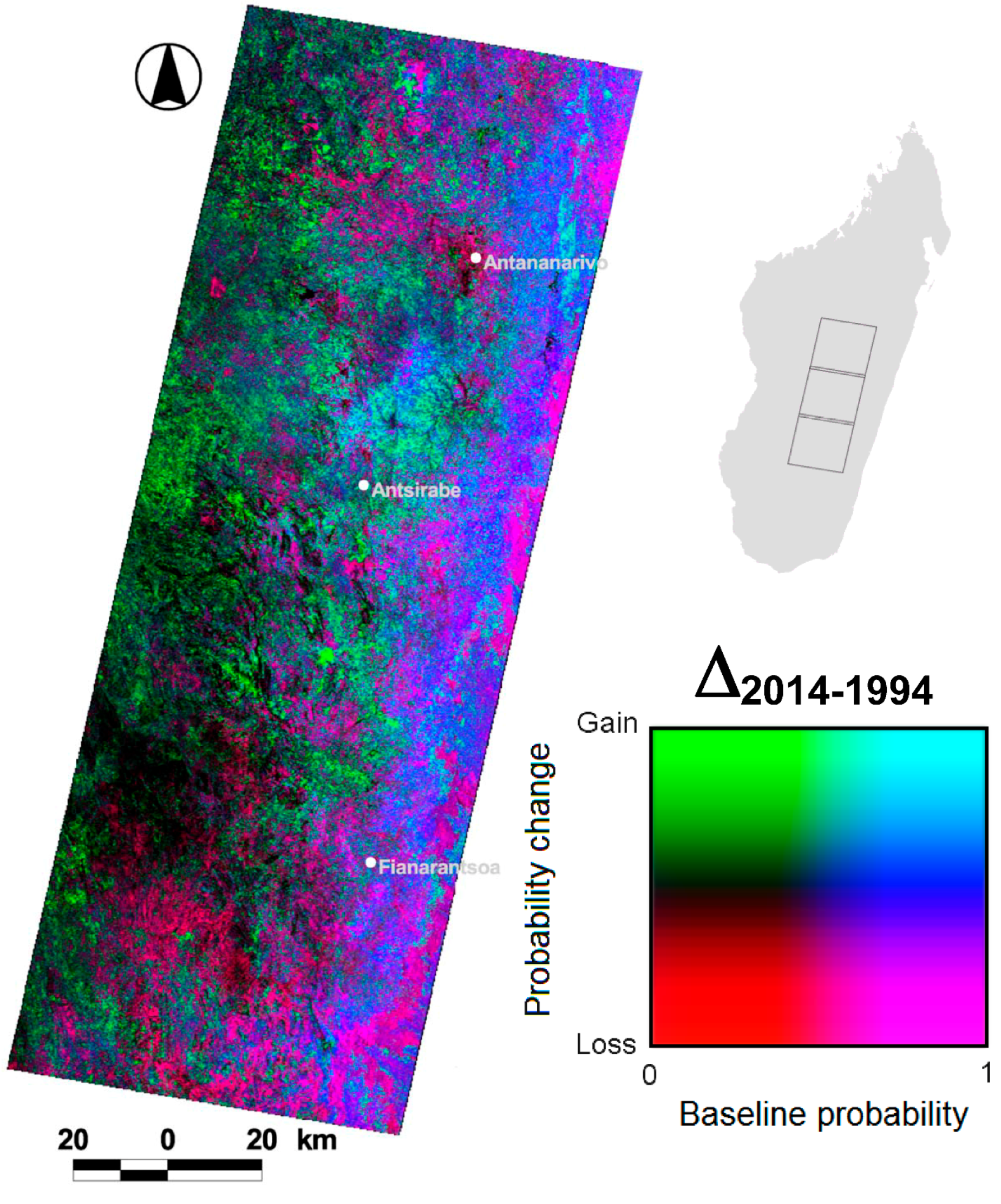
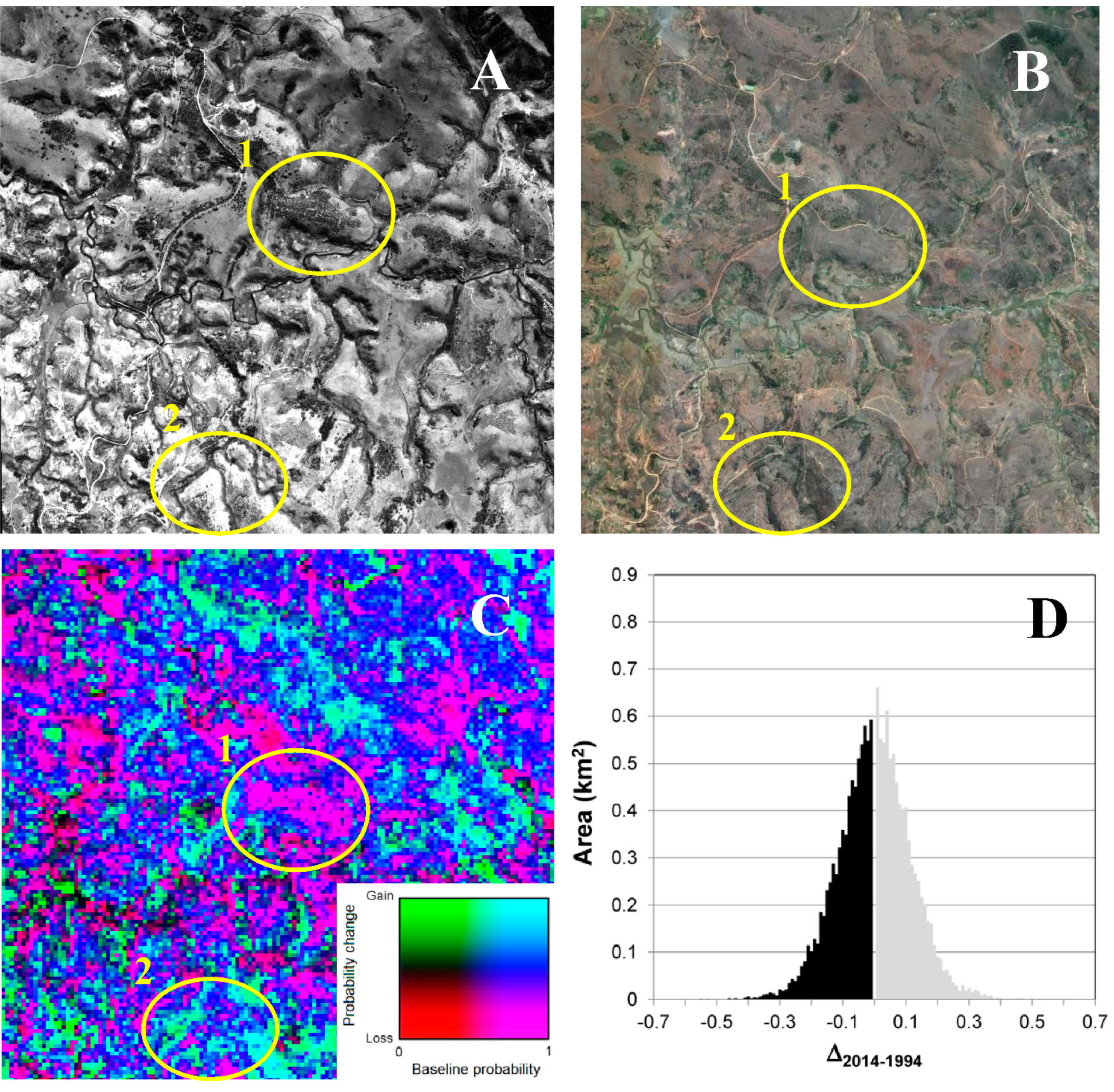
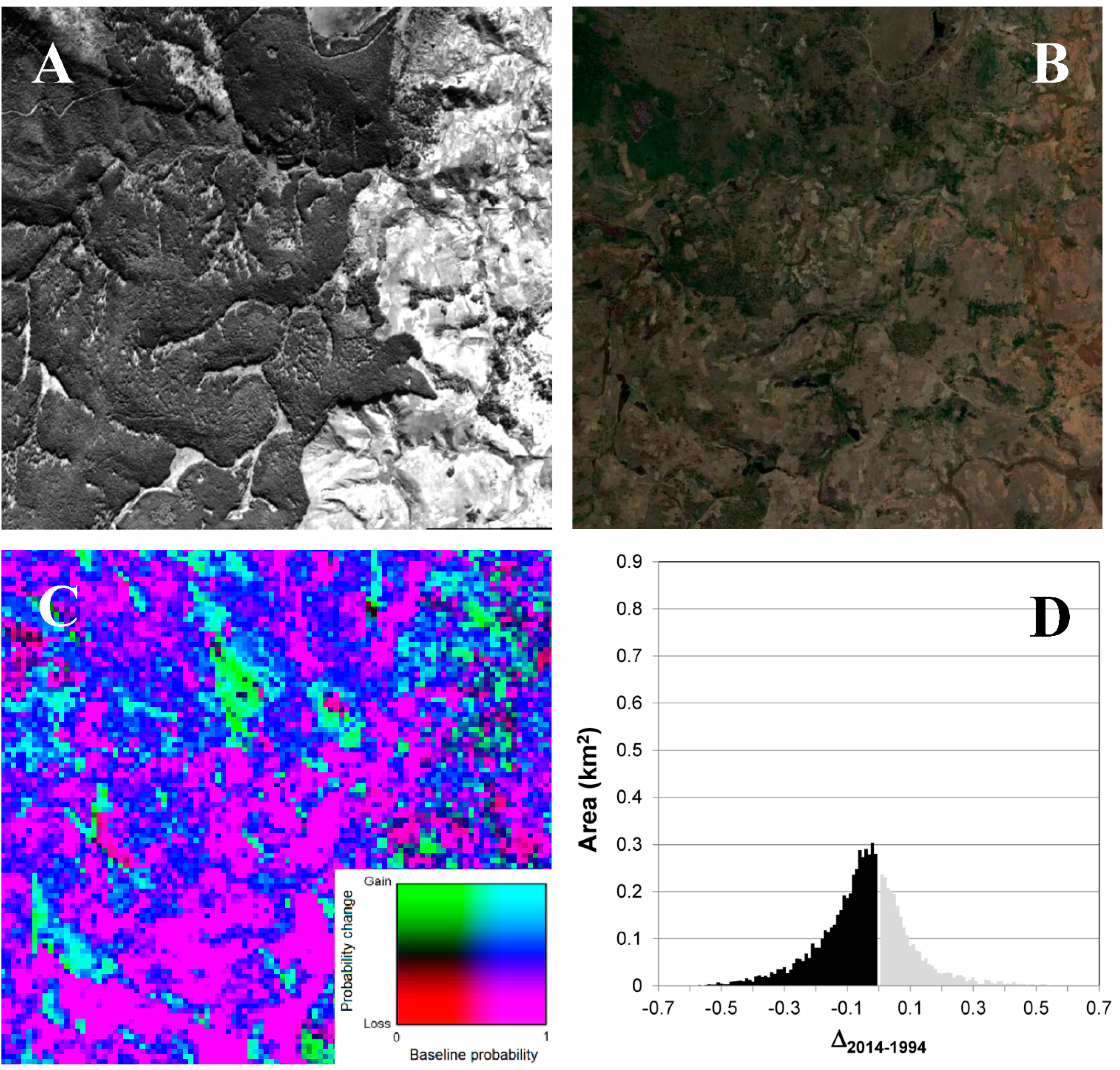
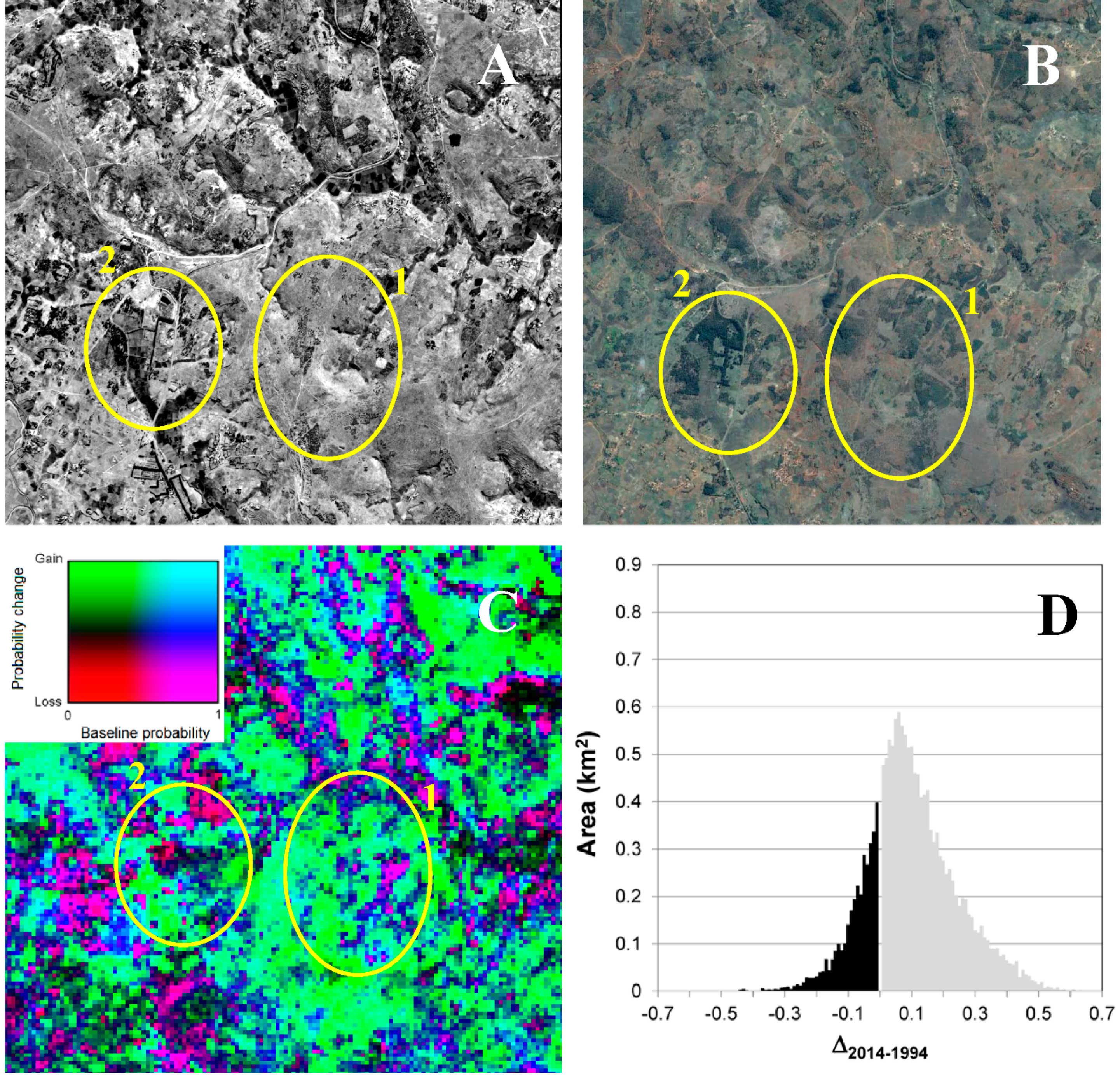
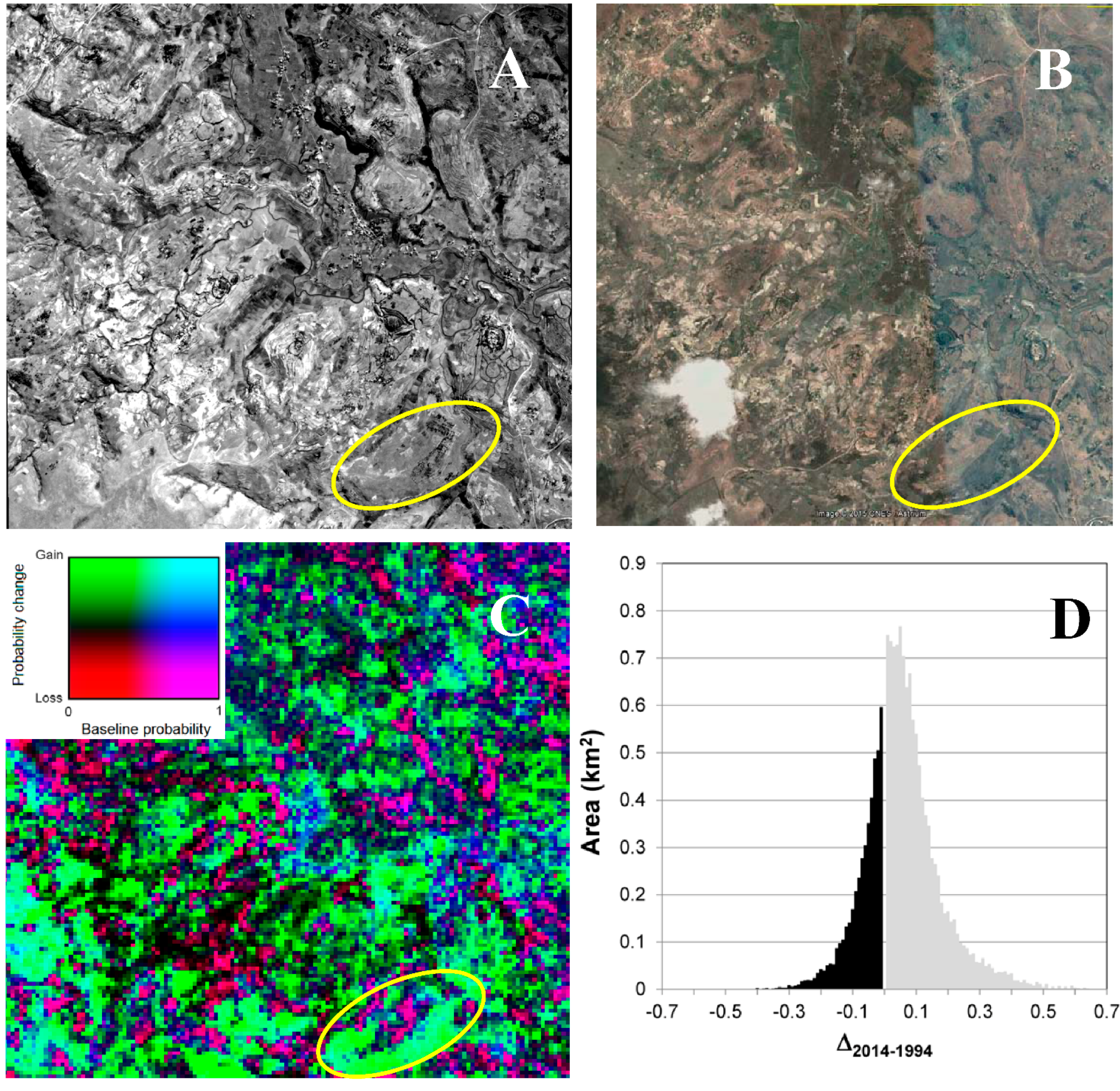
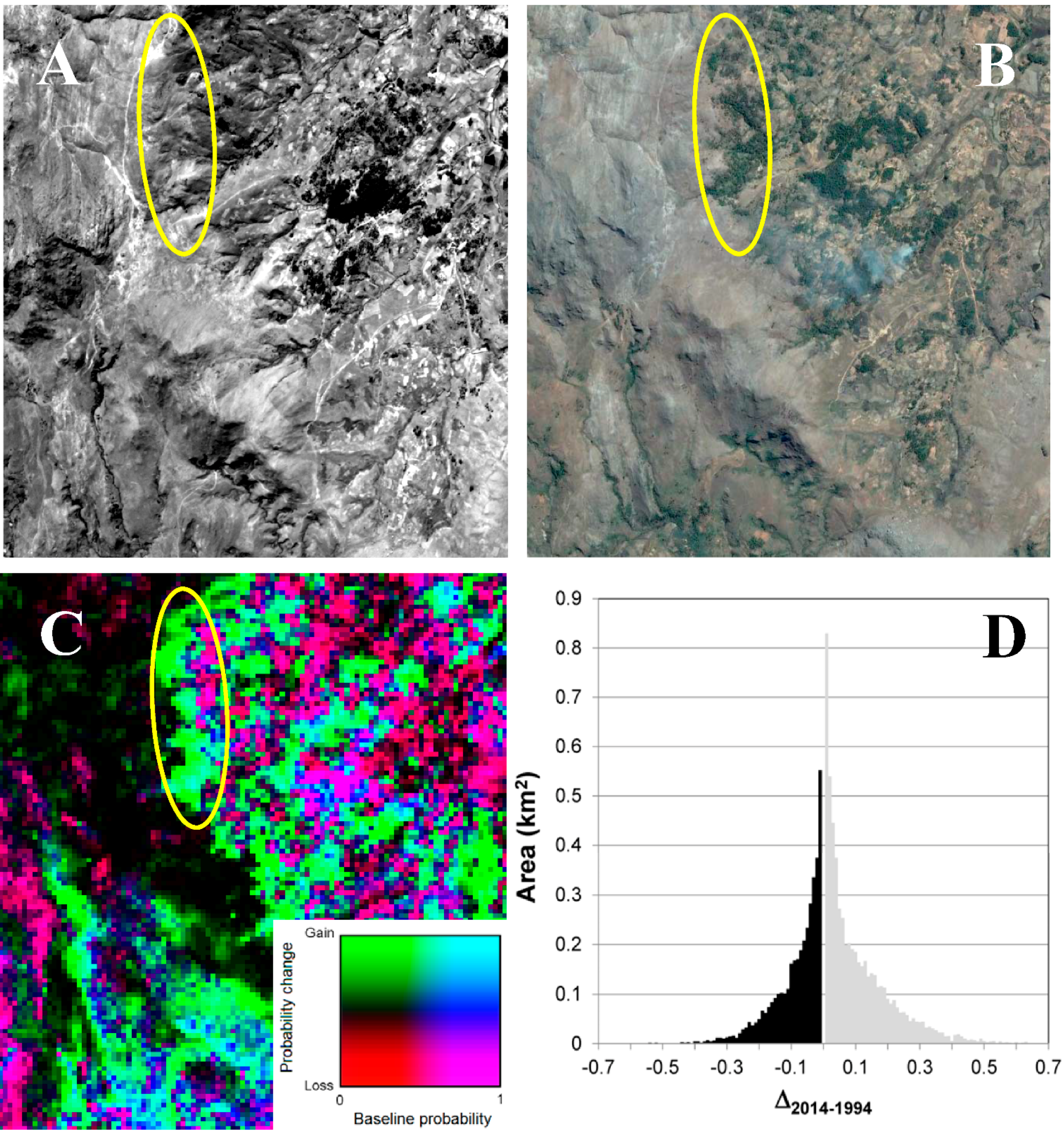
4.2. Political Ecological Context of Tree Cover Change
5. Discussion and Conclusions
5.1. On Pathways and Processes of Forest Transitions and Landscape Change
5.2. On Resilient Livelihoods and Sustainable Environments
5.3. Future Directions
Supplementary Files
Supplementary File 1Acknowledgments
Author Contributions
Conflicts of Interest
References
- Harper, G.J.; Steininger, M.K.; Tucker, C.J.; Juhn, D.; Hawkins, F. Fifty years of deforestation and forest fragmentation in Madagascar. Environ. Conserv. 2007, 34, 325–333. [Google Scholar] [CrossRef]
- Kull, C.A.; Ibrahim, C.K.; Meredith, T.C. Tropical forest transitions and globalization: NEO-liberalism, migration, tourism, and international conservation agendas. Soc. Nat. Resour. 2007, 20, 723–737. [Google Scholar] [CrossRef]
- Brannstrom, C.; Vadjunec, J.M. Notes for avoiding a missed opportunity in sustainability science: Integrating land change science and political ecology. In Land Change Science, Political Ecology, and Sustainability Synergies and Divergences; Brannstrom, C., Vadjunec, J.M., Eds.; Routledge: New York, NY, USA, 2013; pp. 1–23. [Google Scholar]
- Mather, A.S.; Needle, C.L. The forest transition: A theoretrical basis. Area 1998, 30, 117–124. [Google Scholar] [CrossRef]
- Rudel, T.K. Is there a forest transition? Deforestation, reforestation, and development. Rural Sociol. 1998, 63, 533–552. [Google Scholar] [CrossRef]
- Foster, A.D.; Rosenzweig, M.R. Economic growth and the rise of forests. Q. J. Econ. 2003, 118, 601–637. [Google Scholar] [CrossRef]
- Kauppi, P.E.; Ausubel, J.H.; Fang, J.; Mather, A.S.; Sedjo, R.A.; Waggoner, P.E. Returning forests analyzed with the forest identity. Proc. Natl. Acad. Sci. USA 2006, 103, 17574–17579. [Google Scholar] [CrossRef] [PubMed]
- Hansen, M.C.; Potapov, P.V.; Moore, R.; Hancher, M.; Turubanova, S.; Tyukavina, A.; Thau, D.; Stehman, S.; Goetz, S.; Loveland, T. High-resolution global maps of 21st-century forest cover change. Science 2013, 342, 850–853. [Google Scholar] [CrossRef] [PubMed]
- Caldas, M.; Walker, R.; Arima, E.; Perz, S.; Aldrich, S.; Simmons, C. Theorizing land cover and land use change: The peasant economy of Amazonian deforestation. Ann. Assoc. Am. Geogr. 2007, 97, 86–110. [Google Scholar] [CrossRef]
- Gutman, G.; Janetos, A.C.; Justice, C.O.; Moran, E.F.; Mustard, J.F.; Rindfuss, R.R.; Skole, D.; Turner, B.L., II; Cochrane, M.A. Land Change Science: Observing, Monitoring and Understanding Trajectories of Change on the Earth's Surface; Kluwer Academic Publishers: Dordrecht, The Netherlands, 2004. [Google Scholar]
- Lambin, E.; Geist, H.; Rindfuss, R.R. Introduction: Local processes with global impacts. In Land Use and Cover Change; Lambin, E., Geist, H., Eds.; Springer: Berlin, Germany, 2006. [Google Scholar]
- Rindfuss, R.R.; Walsh, S.J.; Turner, B.L.; Fox, J.; Mishra, V. Developing a science of land change: Challenges and methodological issues. Proc. Natl Acad. Sci. USA 2004, 101, 13976–13981. [Google Scholar] [CrossRef] [PubMed]
- Rudel, T.K.; Coomes, O.T.; Moran, E.; Achard, F.; Angelsen, A.; Xu, J.C.; Lambin, E. Forest transitions: Towards a global understanding of land use change. Glob. Environ. Change-Hum. Policy Dimens. 2005, 15, 23–31. [Google Scholar] [CrossRef]
- Von Thünen, J.H. Die isolierte Staat in Beziehung auf Landwirtshaft und Nationalökonomie; Wartenberg, C.M., Translator; Pergamon Press: New York, NY, USA, 1826. [Google Scholar]
- Angelsen, A. Forest Cover Change in Space and Time: Combining the von Thünen and Forest Transition Theories; World Bank Policy Research Working Paper 4117; World Bank: Washington, DC, USA, 2007. [Google Scholar]
- Perz, S.G. Grand theory and context-specificity in the study of forest dynamics: Forest transition theory and other directions. Prof. Geogr. 2007, 59, 105–114. [Google Scholar] [CrossRef]
- Whittaker, R.J.; Grainger, A. Tropical open woodlands special issue—Introduction. Glob. Ecol. Biogeogr. 1999, 8, 177–178. [Google Scholar] [CrossRef]
- Aspinall, R. Modelling land use change with generalized linear models—A multi-model analysis of change between 1860 and 2000 in Gallatin Valley, Montana. J. Environ. Manag. 2004, 72, 91–103. [Google Scholar] [CrossRef] [PubMed]
- Evans, T.P.; Kelley, H. Multi-scale analysis of a household level agent-based model of landcover change. J. Environ. Manag. 2004, 72, 57–72. [Google Scholar] [CrossRef] [PubMed]
- Kok, K. The role of population in understanding Honduran land use patterns. J. Environ. Manag. 2004, 72, 73–89. [Google Scholar] [CrossRef] [PubMed]
- Walsh, S.J.; Evans, T.P.; Welsh, W.F.; Entwisle, B.; Rindfuss, R.R. Scale-dependent relationships between population and environment in northeastern Thailand. Photogramm. Eng. Remote Sens. 1999, 65, 97–105. [Google Scholar]
- Perz, S.G.; Skole, D.L. Secondary forest expansion in the Brazilian Amazon and the refinement of forest transition theory. Soc. Nat. Resour. 2003, 16, 277–294. [Google Scholar] [CrossRef]
- Klooster, D. Forest transitions in Mexico: institutions and forests in a globalized countryside. Prof. Geogr. 2003, 55, 227–237. [Google Scholar]
- Walker, R. Deforestation and economic development. Can. J. Reg. Sci. 1993, 16, 481–497. [Google Scholar]
- Farley, K.A. Grasslands to tree plantations: forest transition in the andes of Ecuador. Ann. Assoc. Am. Geogr. 2007, 97, 755–771. [Google Scholar] [CrossRef]
- Southworth, J.; Nagendra, H.; Cassidy, L. Forest transition pathways in Asia—Studies from Nepal, India, Thailand, and Cambodia. J. Land Use Sci. 2012, 7, 51–65. [Google Scholar] [CrossRef]
- Meyfroidt, P.; Lambin, E.F. Forest transition in Vietnam and Bhutan: Causes and environmental impacts. In Reforesting Landscapes; Nagendra, H., Southworth, J., Eds.; Springer: Dordrecht, The Netherlands, 2010; pp. 315–339. [Google Scholar]
- Xu, J.; Yang, Y.; Fox, J.; Yang, X. Forest transition, its causes and environmental consequences: Empirical evidence from Yunnan of Southwest China. Trop. Ecol. 2007, 48, 137. [Google Scholar]
- Hecht, S.B.; Morrison, K.D.; Padoch, C. The Social Lives of Forests: Past, Present, and Future of Woodland Resurgence; University of Chicago Press: Chicago, IL, USA, 2014. [Google Scholar]
- Nagendra, H.; Southworth, J. Reforesting Landscapes: Linking Pattern and Process; Springer Science & Business Media: Dordrecht, The Netherlands, 2009. [Google Scholar]
- Peet, R.; Watts, M. Liberation Ecologies; Routledge: London, UK, 2004. [Google Scholar]
- Robbins, P. Political Ecology: A Critical Introduction; Blackwell: Oxford, UK, 2004. [Google Scholar]
- Batterbury, S.P.J.; Bebbington, A.J. Environmental histories, access to resources and landscape change: An introduction. Land Degrad. Dev. 1999, 10, 279–289. [Google Scholar] [CrossRef]
- Tiffen, M.; Mortimore, M.; Gichuki, F. More People, Less Erosion; John Wiley and Sons: Chichester, UK, 1994. [Google Scholar]
- Fairhead, J.; Leach, M. Misreading the African Landscape; Cambridge University Press: Cambridge, UK, 1996. [Google Scholar]
- Leach, M.; Mearns, R. Lie of the Land: Challenging Received Wisdom on the African Environment; James Currey: Oxford, UK, 1996. [Google Scholar]
- McCann, J.C. The plow and the forest—Narratives of deforestation in Ethiopia, 1840–1992. Environ. Hist. 1997, 2, 138–159. [Google Scholar] [CrossRef]
- Kull, C.A. Deforestation, erosion, and fire: Degradation myths in the environmental history of Madagascar. Environ. Hist. 2000, 6, 423–450. [Google Scholar] [CrossRef]
- Mortimore, M.; Tiffen, M. Population and Environment in Time Perspective: The Machakos Story; John Wiley and Sons: Chichester, UK, 1995. [Google Scholar]
- Arnold, J.E.M.; DeWees, P. Farms, Trees and Farmers; Earthscan: London, UK, 1997. [Google Scholar]
- Clinecole, R.A. Manufacturing Forests & Farming Trees in Nigeria. In The Lie of the Land: Challenging Received Wisdom on the African Environment; Leach, M., Mearns, R., Eds.; Heineman: Portsmouth, UK, 1996; pp. 122–139. [Google Scholar]
- Weston, P.; Hong, R.; Kaboré, C.; Kull, C.A. Farmer-managed natural regeneration enhances rural livelihoods in dryland west Africa. Environ. Manag. 2015, 55, 1402–1417. [Google Scholar] [CrossRef] [PubMed]
- Fortmann, L.; Bruce, J.W. Whose Trees? Proprietary Dimensions of Forestry; Westview Press: Boulder, CO, USA, 1998. [Google Scholar]
- Rocheleau, D.; Edmunds, D. Women, men and trees: Gender, power and property in forest and agrarian landscapes. World Dev. 1997, 25, 1351–1371. [Google Scholar] [CrossRef]
- Mather, A.S. Recent Asian forest transitions in relation to forest-transition theory. Int. For. Rev. 2007, 9, 491–502. [Google Scholar]
- Dietz, T.; Ostrom, E.; Stern, P.C. The struggle to govern the commons. Science 2003, 302, 1907–1912. [Google Scholar] [CrossRef] [PubMed]
- Moran, E.; Ostrom, E. Seeing the Forest and the Trees: Human-Environment Interactions in Forest Ecosystems; MIT Press: Cambridge, MA, USA, 2005. [Google Scholar]
- Dufils, J.M. Remaining forest cover. In The Natural History of Madagascar; Goodman, S., Benstead, J., Eds.; The University of Chicago Press: Chicago, IL, USA, 2003; pp. 88–96. [Google Scholar]
- McConnell, W.; Kull, C.A. Deforestation in Madagascar: Debates over the island’s forest cover and challenges of measuring forest change. In Conservation and Environmental Management in Madagascar; Scales, I.R., Ed.; Earthscan Conservation and Development Series; Routledge: London, UK, 2014; pp. 67–104. [Google Scholar]
- Hansen, M.; DeFries, R.; Townshend, J.; Carroll, M.; Dimiceli, C.; Sohlberg, R. Global percent tree cover at a spatial resolution of 500 meters: First results of the MODIS vegetation continuous fields algorithm. Earth Interact. 2003, 7, 1–15. [Google Scholar] [CrossRef]
- Barrett, C.B. Food marketing liberalization and trader entry: evidence from Madagascar. World Dev. 1997, 25, 763–777. [Google Scholar] [CrossRef]
- Fraslin, J.H. Quel avenir pour les paysans de Madagascar? Afr. Contemp. 2002, 202–203, 93–110. [Google Scholar]
- Minten, B.; Randrianarison, L.; Swinnen, J.F. Global retail chains and poor farmers: Evidence from Madagascar. World Dev. 2009, 37, 1728–1741. [Google Scholar] [CrossRef]
- Minten, B.; Barrett, C.B. Agricultural technology, productivity, and poverty in Madagascar. World Dev. 2008, 36, 797–822. [Google Scholar] [CrossRef]
- Rakoto Ramiarantsoa, H. Chair de la Terre, Oeil de l'Eau... Paysanneries et Recompositions de Campagnes en Imerina (Madagascar); Éditions de l'Orstom: Paris, France, 1995. [Google Scholar]
- Fafchamps, M.; Moser, C. Crime, Isolation, and Law Enforcement. J. Afr. Econ. 2003, 12, 625–671. [Google Scholar] [CrossRef]
- Olson, S. Environments as shock absorbers, examples from Madagascar. Environ. Hist. Rev. 1988, 12, 61–80. [Google Scholar] [CrossRef]
- Shackleton, C.; Shackleton, S. The importance of non-timber forest products in rural livelihood security and as safety nets: A review of evidence from South Africa. S. Afr. J. Sci. 2004, 100, 658–664. [Google Scholar]
- Montagne, P.; Bertrand, A. Kajiala, Tattali, Djekabaara: Valoriser les produits pour mieux conserver les forêts. Tome 1: les expériences nationales Volume 1: Madagascar; Projet GESFORCOM; Antananarivo, Madagascar, 2012. [Google Scholar]
- Gardner, C.J.; Gabriel, F.U.; St John, F.A.; Davies, Z.G. Changing livelihoods and protected area management: A case study of charcoal production in south-west Madagascar. Oryx 2014. [Google Scholar] [CrossRef]
- Raison, J.P. Les hautes terres de Madagascar et leurs confins occidentaux: enracinement et mobilité des sociétés rurales; Karthala Editions: Paris, France, 1984. [Google Scholar]
- République. In Regions et Developpement: Programmes regionaux et projects locaux (Fianarantsoa); République de Madagascar, Ministere de l’Economie at du Plan; Programme des Nations Unies pour le Developpement Projet PNUD/OPS MAG/89/018; Dirasset: Tunis, Tunisia, 1991.
- Kull, C.A. Isle of Fire: the Political Ecology of Landscape Burning in Madagascar; University of Chicago Press: Chicago, IL, USA, 2004. [Google Scholar]
- Gade, D.W. Deforestation and its effects in highland Madagascar. Mt. Res. Dev. 1996, 16, 101–116. [Google Scholar] [CrossRef]
- Jolly, A. Madagascar: A world apart. Natl. Geogr. 1987, 171, 148–183. [Google Scholar]
- Unruh, J.D.; McConnell, W.; Rodman, J. Environmental change and adaptation in degraded agro-ecosystems: the case of highland Madagascar. Area 2010, 42, 359–368. [Google Scholar] [CrossRef]
- Jaynes, E.T. Information theory and statistical mechanics. Phys. Rev. 1957, 106, 620–630. [Google Scholar] [CrossRef]
- Phillips, S.J.; Anderson, R.P.; Schapire, R.E. Maximum entropy modeling of species geographic distributions. Ecol. model. 2006, 190, 231–259. [Google Scholar] [CrossRef]
- FAO. Global Forest Resources Assessment 2010; Food and Agriculture Organization of the United Nations: Rome, Italy, 2010. [Google Scholar]
- Hanley, J.A.; Mcneil, B.J. The meaning and use of the area under a receiver operating characteristic (ROC) curve. Radiology 1982, 143, 29–36. [Google Scholar] [CrossRef] [PubMed]
- Coppin, P.; Jonckheere, I.; Nackaerts, K.; Muys, B.; Lambin, E. Digital change detection methods in ecosystem monitoring: a review. Int. J. Remote Sens. 2004, 25, 1565–1596. [Google Scholar] [CrossRef]
- Kull, C.A. Air photo evidence of historical land cover change in the highlands: wetlands and grasslands give way to crops and woodlots. Madag. Conserv. Dev. 2012, 7, 144–152. [Google Scholar] [CrossRef]
- Kull, C.A. Leimavo revisited: Agrarian land-use change in the highlands of Madagascar. Prof. Geogr. 1998, 50, 163–176. [Google Scholar] [CrossRef]
- McConnell, W.J.; Sweeney, S.P. Challenges of forest governance in Madagascar. Geogr. J. 2005, 171, 223–238. [Google Scholar] [CrossRef]
- Verhaegen, D.; Randrianjafy, H.; Montagne, P.; Danthu, P.; Rabevohitra, R.; Tassin, J.; Bouvet, J.-M. Historique de l'introduction du genre Eucalyptus à Madagascar. Bois et Forêt des Tropiques 2011, 17–25. [Google Scholar]
- Kull, C.A. Historical landscape repeat photography as a tool for land use change research. Norsk Geografisk Tidsskrift 2005, 59, 253–268. [Google Scholar] [CrossRef]
- Ragin, C.C. The Comparative Method: Moving beyond Qualitative and Quantitative Strategies; University of California Press: Berkeley, CA, USA, 2014. [Google Scholar]
- Rudel, T.K. Tropical Forests: Paths of Destruction and Regeneration; Columbia University Press: New York, NY, USA, 2013. [Google Scholar]
- Carrière, S.M.; Randriambanona, H. Biodiversité introduite et autochtone: antagonisme ou complémentarité? Le cas de l'eucalyptus à Madagascar. Bois et Forêts des Tropiques 2007, 292, 5–21. [Google Scholar]
- Kull, C.A.; Tassin, J.; Rangan, H. Multifunctional, scrubby, and invasive forests? Wattles in the highlands of Madagascar. Mt. Res. Dev. 2007, 27, 224–231. [Google Scholar] [CrossRef]
- Tassin, J.; Rangan, H.; Kull, C.A. Hybrid improved tree fallows: harnessing invasive woody legumes for agroforestry. Agrofor. Syst. 2012, 84, 417–428. [Google Scholar] [CrossRef]
- The World Bank Group. Madagascar: Systemic Country Diagnostic; Report #99197; The World Bank: Washington, DC, USA, 2015. [Google Scholar]
- Van der Walle, N. African Economies and the Politics of Permanent Crisis; Cambridge University Press: Cambridge, UK, 2001. [Google Scholar]
- Rakoto Ramiarantsoa, H. Les boisements d'eucalyptus dans l'est de l'Imerina (Madagascar). In Terre, Terroir, Territoire: Les Tensions Fonciers; Blanc-Pamard, C., Cambrézy, L., Eds.; OSTROM: Paris, France, 1995; pp. 83–103. [Google Scholar]
- Bertrand, A. La Dynamique Seculaire des Plantations Paysannes d'Eucalyptus sur les Hautes Terres Malgaches. Afr. Stud. Q. 1999, 3, 61–68. [Google Scholar]
- Carrière, S.M.; Andrianotahiananahary, H.; Ranaivoarivelo, N.; Randriamalala, J. Savoirs et Usages des Recrus Post-Agricoles du Pays Betsileo: Valorisation d'une Biodiversite Oubliee a Madagascar. VertigO – La revue en sciences de l'environnement 2005, 16, 1–15. [Google Scholar] [CrossRef]
- Verhaegen, D.; Randrianjafy, H.; Rakotondraoelina, H.; Trendelenburg Rakotonirina, M.-C.; Andriamampianina, N.; Montagne, P.; Rasamindisa, A.; Chaix, G.; Bouillet, J.-P.; Bouvet, J.-M. Eucalyptus robusta pour une production durable de bois énergie à Madagascar: Bilan des connaissances et perspectives. Bois et Forêts des Tropiques 2014, 320, 15–30. [Google Scholar]
- Bertrand, A. Le boisement, le bail, et la législation environnemental à Madagascar: trois articles courts. Afr. Stud. Q. 1999, 3, 47–59. [Google Scholar]
- Gade, D.W.; Perkins-Belgram, A. Woodfuels, reforestation, and ecodevelopment in highland Madagascar. GeoJournal 1986, 12, 365–374. [Google Scholar] [CrossRef]
- Office National de Forets. Reboisement Communautaire des Hautes Terres, Madagascar. 2010. Available online: http://www.developpement-durable.gouv.fr/IMG/pdf/Madagascar_ONF_Reboisement.pdf (accessed on 13 November 2015).
- Minten, B.; Sander, K.; Stifel, D. Forest management and economic rents: Evidence from the charcoal trade in Madagascar. Energy Sustain. Dev. 2013, 17, 106–115. [Google Scholar] [CrossRef]
- Root, H. Environment for Investment in Madagascar: Institutional Reform for Market Economy; Center for Institutional Reform and the Informal Sector, University of Maryland at College Park: College Park, MD, USA, 1993. [Google Scholar]
- Gore, M.L.; Ratsimbazafy, J.; Lute, M.L. Rethinking corruption in conservation crime: Insights from Madagascar. Conserv. Lett. 2013, 6, 430–438. [Google Scholar] [CrossRef]
- Kull, C.A.; Tassin, J.; Carriere, S.M. Approaching invasive species in Madagascar. Madag. Conserv. Dev. 2014, 9, 60–70. [Google Scholar] [CrossRef]
- Richardson, D.M.; Rejmánek, M. Trees and shrubs as invasive alien species—A global review. Divers. Distrib. 2011, 17, 788–809. [Google Scholar] [CrossRef]
- Van Wilgen, B.W.; Richardson, D.M. Challenges and trade-offs in the management of invasive alien trees. Biol. Invasions 2014, 16, 721–734. [Google Scholar] [CrossRef]
- Laney, R.M. Disaggregating induced intensification for land-change analysis: A case study from Madagascar. Ann. Assoc. Am. Geogr. 2002, 92, 702–726. [Google Scholar] [CrossRef]
- Lerner, A.M.; Rudel, T.K.; Schneider, L.C.; McGroddy, M.; Burbano, D.V.; Mena, C.F. The spontaneous emergence of silvo-pastoral landscapes in the Ecuadorian Amazon: Patterns and processes. Reg. Environ. Change 2014, 15, 1–11. [Google Scholar] [CrossRef]
- Lambin, E.F.; Meyfroidt, P. Land use transitions: Socio-ecological feedback versus socio-economic change. Land Use Policy 2010, 27, 108–118. [Google Scholar] [CrossRef]
- Meyfroidt, P. Environmental cognitions, land change and social-ecological feedbacks: Local case studies of forest transition in Vietnam. Hum. Ecol. 2013, 41, 367–392. [Google Scholar] [CrossRef]
- Boserup, E. The Conditions of Agricultural Progress; Aldine Publishing Company: Chicago, IL, USA, 1965. [Google Scholar]
- Kull, C.A. Saving the land with spades: human landscape transformations in the central highlands. In Greening the Great Red Island: Madagascar in Nature and Culture; Kaufmann, J.C., Ed.; Africa Institute of South Africa: Pretoria, South Africa, 2008; pp. 113–135. [Google Scholar]
- Blanc-Pamard, C.; Rakoto Ramiarantsoa, H. Le Terroir et son Double: Tsarahonenana 1966–1992 Madagascar; Editions de l’Institut de Recherches pour le Developpement: Paris, France, 2000. [Google Scholar]
- Owen, M.; van der Plas, R.; Sepp, S. Can there be energy policy in Sub-Saharan Africa without biomass? Energy Sustain. Dev. 2013, 17, 146–152. [Google Scholar] [CrossRef]
- Chidumayo, E.N.; Gumbo, D.J. The environmental impacts of charcoal production in tropical ecosystems of the world: A synthesis. Energy Sustain. Dev. 2013, 17, 86–94. [Google Scholar] [CrossRef]
- Zulu, L.C.; Richardson, R.B. Charcoal, livelihoods, and poverty reduction: Evidence from sub-Saharan Africa. Energy Sustain. Dev. 2013, 17, 127–137. [Google Scholar] [CrossRef]
- Ghilardi, A.; Mwampamba, T.; Dutt, G. What role will charcoal play in the coming decades? Insights from up-to-date findings and reviews. Energy Sustain. Dev. 2013, 2, 73–74. [Google Scholar] [CrossRef]
- Rocheleau, D. More on Machakos. Environment 1995, 37, 3–5. [Google Scholar]
- Bruijnzeel, L.A. Hydrological functions of tropical forests: not seeing the soil for the trees? Agric. Ecosyst. Environ. 2004, 104, 185–228. [Google Scholar] [CrossRef]
- Baohanta, R.; Thioulouse, J.; Ramanankierana, H.; Prin, Y.; Rasolomampianina, R.; Baudoin, E.; Rakotoarimanga, N.; Galiana, A.; Randriambanona, H.; Lebrun, M. Restoring native forest ecosystems after exotic tree plantation in Madagascar: Combination of the local ectotrophic species Leptolena bojeriana and Uapaca bojeri mitigates the negative influence of the exotic species Eucalyptus camaldulensis and Pinus patula. Biol. Invasions 2012, 14, 2407–2421. [Google Scholar]
- Ganzhorn, J.U. A possible role of plantations for primate conservation in Madagascar. Am. J. Primatol. 1987, 12, 205–215. [Google Scholar] [CrossRef]
- Martin, E.A.; Viano, M.; Ratsimisetra, L.; Laloë, F.; Carrière, S.M. Maintenance of bird functional diversity in a traditional agroecosystem of Madagascar. Agric. Ecosyst. Environ. 2012, 149, 1–9. [Google Scholar] [CrossRef]
- Kull, C.A.; Carrière, S.M.; Moreau, S.; Ramiarantsoa, H.R.; Blanc-Pamard, C.; Tassin, J. Melting pots of biodiversity: Tropical smallholder farm landscapes as guarantors of sustainability. Environ.: Sci. Policy Sustain. Dev. 2013, 55, 6–16. [Google Scholar] [CrossRef]
- Gérard, A.; Ganzhorn, J.U.; Kull, C.A.; Carriere, S.M. Possible roles of introduced plants for native vertebrate conservation: The case of Madagascar. Restor. Ecol. 2015, 23, 768–775. [Google Scholar] [CrossRef]
- Razakamanarivo, R.H.; Grinand, C.; Razafindrakoto, M.A.; Bernoux, M.; Albrecht, A. Mapping organic carbon stocks in eucalyptus plantations of the central highlands of Madagascar: A multiple regression approach. Geoderma 2011, 162, 335–346. [Google Scholar] [CrossRef]
© 2015 by the authors; licensee MDPI, Basel, Switzerland. This article is an open access article distributed under the terms and conditions of the Creative Commons Attribution license (http://creativecommons.org/licenses/by/4.0/).
Share and Cite
McConnell, W.J.; Viña, A.; Kull, C.; Batko, C. Forest Transition in Madagascar’s Highlands: Initial Evidence and Implications. Land 2015, 4, 1155-1181. https://doi.org/10.3390/land4041155
McConnell WJ, Viña A, Kull C, Batko C. Forest Transition in Madagascar’s Highlands: Initial Evidence and Implications. Land. 2015; 4(4):1155-1181. https://doi.org/10.3390/land4041155
Chicago/Turabian StyleMcConnell, William J., Andrés Viña, Christian Kull, and Clayton Batko. 2015. "Forest Transition in Madagascar’s Highlands: Initial Evidence and Implications" Land 4, no. 4: 1155-1181. https://doi.org/10.3390/land4041155






